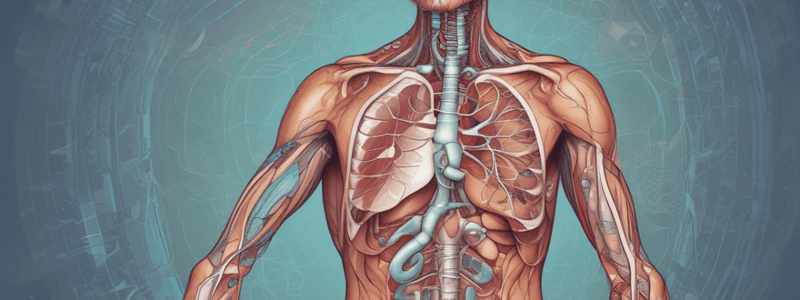Podcast
Questions and Answers
What is the main function of the respiratory system?
What is the main function of the respiratory system?
- Producing hormones for body functions
- Providing oxygen to organs and tissues (correct)
- Assisting in digestion
- Regulating body temperature
Which part of the respiratory system filters air and provides a large surface area for gas exchange in the alveoli?
Which part of the respiratory system filters air and provides a large surface area for gas exchange in the alveoli?
- Trachea
- Pharynx
- Bronchi (correct)
- Larynx
What is the name for abnormal bluish (blue ) coloration of the skin due to low level of oxygen ?
What is the name for abnormal bluish (blue ) coloration of the skin due to low level of oxygen ?
- Jaundice
- Cyanosis (correct)
- Erythema
- Organomegaly
Which organ controls the respiratory system by regulating breathing through muscle movements?
Which organ controls the respiratory system by regulating breathing through muscle movements?
Where does the exchange of gases between the air and blood occur in the respiratory system?
Where does the exchange of gases between the air and blood occur in the respiratory system?
What happens to the chest cavity during exhalation in the respiratory process?
What happens to the chest cavity during exhalation in the respiratory process?
What is the main function of the lower respiratory tract in the human body?
What is the main function of the lower respiratory tract in the human body?
Which part of the respiratory system is NOT part of the upper respiratory tract?
Which part of the respiratory system is NOT part of the upper respiratory tract?
The lung disease Bronchiectasis is?
The lung disease Bronchiectasis is?
The medical term COPD for some lung diseases is?
The medical term COPD for some lung diseases is?
Snoring is produced by
Snoring is produced by
Accumulation of fluid in pleural membrane is a disease called ?
Accumulation of fluid in pleural membrane is a disease called ?
Flashcards
Respiratory System Function
Respiratory System Function
Provides oxygen to organs and tissues, removing carbon dioxide.
Bronchi Function
Bronchi Function
Filters air and provides large surface area for gas exchange in the alveoli.
Cyanosis Definition
Cyanosis Definition
Bluish skin coloration due to low oxygen levels.
Respiratory Control
Respiratory Control
Signup and view all the flashcards
Gas Exchange Location
Gas Exchange Location
Signup and view all the flashcards
Exhalation Chest Change
Exhalation Chest Change
Signup and view all the flashcards
Lower Respiratory Tract Function
Lower Respiratory Tract Function
Signup and view all the flashcards
Upper vs. Lower Respiratory Tract
Upper vs. Lower Respiratory Tract
Signup and view all the flashcards
Bronchiectasis Definition
Bronchiectasis Definition
Signup and view all the flashcards
COPD Definition
COPD Definition
Signup and view all the flashcards
Snoring Cause
Snoring Cause
Signup and view all the flashcards
Pleural Effusion Definition
Pleural Effusion Definition
Signup and view all the flashcards
Study Notes
- The respiratory system is crucial for breathing, speaking, singing, and exchanging gases in our bodies.
- Its main function is to provide oxygen to all organs and tissues while removing carbon dioxide.
- Oxygen is essential for cellular functions to convert food into energy.
- The respiratory system consists of the upper and lower respiratory tracts, with the upper part including the nose, pharynx, and larynx.
- The lower respiratory tract includes the trachea, bronchi, bronchioles, and lungs where gas exchange occurs.
- The bronchi and bronchioles help in filtering air and providing a large surface area for efficient gas exchange in the alveoli.
- The respiratory system is controlled by the nervous system, specifically the brain, which regulates breathing through muscle movements in the chest and diaphragm.- The respiratory system consists of various organs, including the lungs, bronchi, and alveoli.
- The air enters the respiratory system through the nose and mouth and travels down the throat and into the trachea.
- The trachea branches into smaller tubes called bronchi, which further divide into bronchioles.
- The exchange of gases between the air and blood occurs in the alveoli, which are thin-walled sacs surrounded by tiny blood vessels called capillaries.
- During exhalation, the muscles between the ribs relax, causing the chest cavity to decrease in size and forcing out carbon dioxide-rich air.
Studying That Suits You
Use AI to generate personalized quizzes and flashcards to suit your learning preferences.




